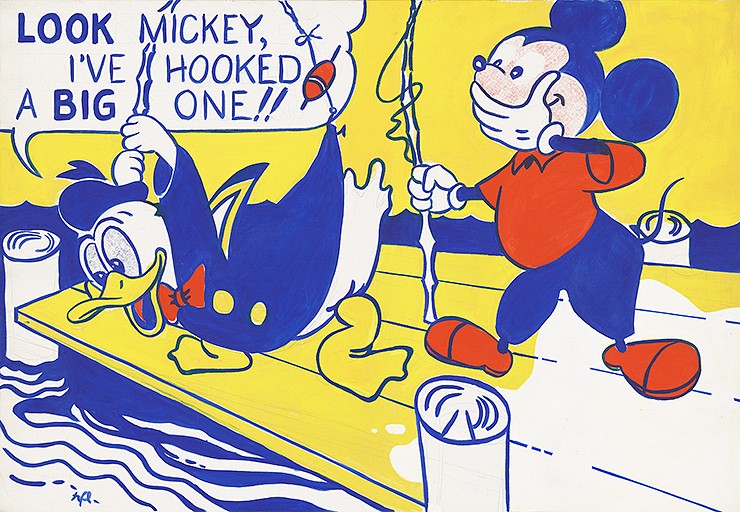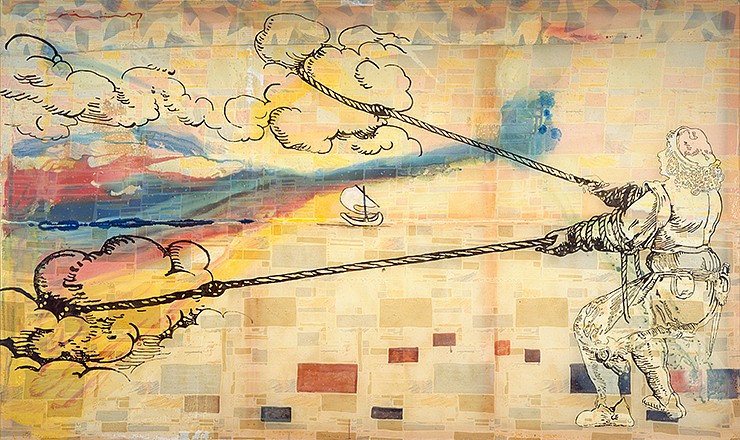Roy Lichtenstein, Look Mickey, 1961, oil on canvas, National Gallery of Art, Washington, Gift of Roy and Dorothy Lichtenstein in Honor of the 50th Anniversary of the National Gallery of Art, 1990.41.1
Remixes
Grade Level: 9–12 Curriculum Connections: Language Arts
Students will examine works of art that involve appropriated images and then create their own works of art appropriating text, music, or images of their choice. Students will follow up with a discussion of how appropriation can become an issue in determining the authenticity of a work.
Sigmar Polke, Hope is: Wanting to Pull Clouds, 1992, polyester resin and acrylic on canvas, National Gallery of Art, Washington, Gift of the Collectors Committee, 1993.59.1
Discussion
Present images of Sigmar Polke’s Hope is: Wanting to Pull Clouds and Roy Lichtenstein’s Look Mickey. Ask students to comment on what they notice about each image:
- What materials appear to be involved in each work?
- What techniques do you think were used in the making of the work?
- How do the colors used contribute to the work?
- Why do you think an artist might choose to use recognizable figures in making his or her own work?
Background
Roy Lichtenstein was born in New York City, and in high school he began to draw and paint. He spent six years working in Cleveland as a draftsman and graphic designer. In 1957 he began to experiment with comic strip characters in his work. In the 1960s and 1970s, Lichtenstein undertook an exploration of the history of Western art. These “quotations” from the history of art culminated with works that incorporated his own earlier paintings. Together they question assumptions about copy and original, reproduction and uniqueness, high and low art. Look Mickey, considered an iconic work of pop art, was Lichtenstein’s first comic strip subject painted in a style that imitated the look of commercial printing. He used bright, primary colors and painted dots, mimicking the dots used in inexpensive color printing in the faces of the two characters. “Although almost anything seemed to be fair subject matter for art, commercial art and particularly cartooning were not considered to be among those possibilities,” said Lichtenstein of his work.
Sigmar Polke was born in what became East Germany. In 1963, Polke and two fellow students launched what they called capitalist realism in response to pop art in the United States. He began to use photographic images, often from newspapers, overlaid with a large-scale pattern of printer’s dots. The dots so abstracted the images that they became almost unrecognizable. In Hope is: Wanting to Pull Clouds, Polke’s image of a boy roping two clouds is copied from a 16th-century German woodcut. The epigram that the woodcut illustrates is the following: “Hope is a long rope, with which many pull themselves toward death.” Polke’s appropriation of the image has given it a new context and a whole new set of possible meanings. Polke chose to reproduce only parts of his source, omitting the god of winds who blows storm gusts to thwart the fiery passion of the youth’s desire. Instead, Polke seems to suggest a romantic wish to harness and even change the world.
The background was stitched together from lengths of commercially printed fabric and attached to a stretcher. Polke treated the surface with polyester resin that made it somewhat transparent. Once the resin had hardened, he poured paint onto the back of the work, tilting to let the pigment flow into various shapes. Only then did he return to the front and paint the image.
Activity
Have students create a work of art that appropriates art from a published source. The appropriated work could, for example, be a sampled image or passage from a music recording, a piece of literature, or an advertisement. In an accompanying short essay, students must explain why they chose to appropriate the particular work and how it relates to their own new work of art. Have the class consider how to display their works in a classroom exhibition.
Extension
American artist Jeff Koons is known for his use of appropriated images. In the 2005 case Blanch v. Koons, Koons won a lawsuit brought against him for his inclusion of a photo that had been used in an advertisement in his work Niagara. Koons won the case because the court decided that his artwork had transformed the photo from the advertisement enough to become an original work.
In 2015, musicians Robin Thicke and Pharrell Williams lost a lawsuit brought against them by the estate of the musician Marvin Gaye for infringing on the copyright of Gaye’s song “Got to Give It Up” in the Thicke/Williams song “Blurred Lines” due to similarities in the compositions of both songs. In 2016, the decision against Thicke and Williams was appealed with support from more than 200 other musicians, who argued that the decision in the case would have the effect of stifling the creativity of artists, who are inspired by the work of those that preceded them.
Keeping in mind their own processes of creating works that drew from various sources, have students determine whether or not they agree with the outcomes of these cases. What is the line between appropriation for artistic purposes and copyright infringement? When does someone else’s work support your own, and when does incorporating others’ work cross the line as misrepresentation of your own work?
National Core Arts Standards
VA:Cn10.1.HSIII Synthesize knowledge of social, cultural, historical, and personal life with art-making approaches to create meaningful works of art or design
VA:Cn11.1.HSIII Appraise the impact of an artist or a group of artists on the beliefs, values, and behaviors of a society
VA:Cr2.1.HSII Through experimentation, practice, and persistence, demonstrate acquisition of skills and knowledge in a chosen art form
VA:Cr3.1.HSIII Reflect on, re-engage, revise, and refine works of art or design considering relevant traditional and contemporary criteria as well as personal artistic vision
VA:Re7.1.HSII Recognize and describe personal aesthetic and empathetic responses to the natural world and constructed environments
VA:Re8.1.HSIII Analyze differing interpretations of an artwork or collection of works in order to select and defend a plausible critical analysis
VA:Re9.1.HSII Determine the relevance of criteria used by others to evaluate a work of art or collection of works
Download or borrow the Art Since 1950 teaching packet
Borrow the 20th-Century American Art DVD
Play the NGAKids Paintbox interactive
Play the NGAKids Photo Op interactive



